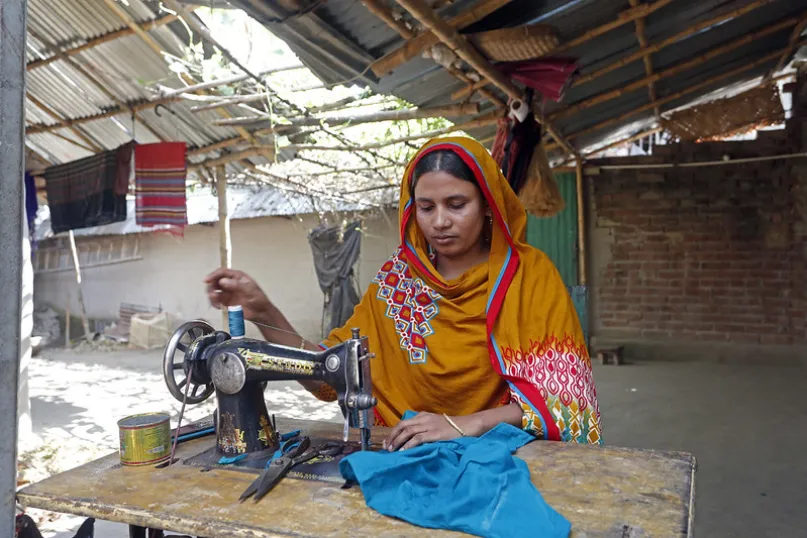Tackling Financial Abuse of Women in Financial Inclusion: A Call to Action

Economic abuse against women and girls is a critical issue that's often overlooked, yet it profoundly impacts their financial independence and empowerment. As practitioners in financial inclusion, we must shine a light on this hidden form of violence. While global recognition of the urgency to end violence against women has gained momentum, economic abuse still lurks in the shadows, underreported and misunderstood.
Financial abuse as a subset of economic abuse encompasses behaviors that control a person's ability to acquire, use, and maintain financial resources. These include controlling tactics and forms of exploitation such as denying women access to household earnings, forcibly taking earnings, withholding inheritance, denying spousal permission for loans, misusing, or not repaying loans taken in a woman's name, tracking transactions in digital accounts, or denying access to smartphones. This severely restricts a woman's ability to gain independence and financial stability - and has serious implications for efforts towards women's economic empowerment.
Given the lack of measurement and inconsistencies in how economic and financial abuse is understood, it is difficult to track and provide accurate estimates of its prevalence. However, where studies have been conducted, this is often found accompanying other forms of violence by intimate partners. Given that 27 percent of women globally have experienced violence from intimate partners in their lifetime, economic and financial abuse is indeed also highly prevalent.
Reflecting on the barriers faced in efforts to improve women's economic empowerment and financial inclusion, we see a striking overlap with the controlling behaviors typical of financial abuse. In both cases, these patterns remain deeply rooted in gender norms that place women in subordinate positions, denying them economic power and control.
Recognizing this, the FinEquity community has prioritized financial abuse against women and girls as a new thematic area. Our recent webinar and week-long virtual #DgroupsDialogue (Post 1 and Post 2) brought together over 130 participants from more than 100 organizations, revealing the depth and complexity of financial abuse. The strong engagement showed a collective desire within the financial inclusion community to address this issue more deeply.
Reflecting on the role of the financial sector
As Bobbi Gray highlighted in her recent blog, financial abuse is often dismissed as a personal issue, outside the remit of financial service providers (FSPs) and difficult to identify. Many FSPs also lack the capacity or knowledge to effectively address financial abuse. Yet, there is a significant opportunity for the financial sector to step up and integrate safety principles into every aspect of their product life cycle.
FSPs can address financial abuse along this spectrum:
- Do no harm: Ensure products and services do not exacerbate financial abuse.
- Proactive measures: Support victims by designing products with protective features, offering specialized support services, and training staff to recognize and respond to signs of abuse.
- Systemic change: Advocate for broader systemic changes, partner with legal and social services, raise awareness about financial abuse, and work to change societal norms that perpetuate gender inequality and financial abuse.
While the ethical imperative for FSPs to address financial abuse is clear, questions about the business case persist. However, for those truly committed to serving women clients in a client-centric way, addressing these root causes is essential.
It is also recognized that financial abuse is a multifaceted issue that cannot be solved by FSPs alone. They can, however, play a crucial and unique role within a broader strategy that includes legal reforms, awareness campaigns, and support services for survivors.
Learning gaps and questions
As we move forward, we need to address several learning gaps and key questions, including but not limited to the following:
- Defining financial abuse: How can we define financial abuse to keep conversations open and relevant for FSPs?
- Perceptions of stakeholders: How do financial sector stakeholders perceive financial abuse, and what barriers do they face in addressing it?
- Scope of FSPs' role: What role should FSPs play in identifying and mitigating financial abuse?
- Intersection with digital: Can digital financial services reduce or exacerbate financial abuse risks?
- Consumer protection measures: How can financial abuse be incorporated into existing frameworks?
- Measurement and data: What data is available to understand the extent of financial abuse? How does this overlap with the data on women’s economic empowerment?
To answer these questions collectively and develop a learning agenda, FinEquity is convening a working group. The group will meet virtually twice, on August 20th and September 25th, 2024 from 8.30 to 10.00 AM EST.
We invite all interested readers to contribute to this effort by directly contacting Swati Mehta Dhawan, Financial Abuse Thematic Lead.


